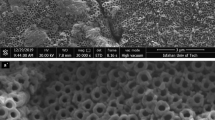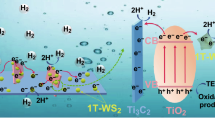Abstract
Coaxial Fe2O3/TiO2 nanotubes (Fe2O3/TiO2 NTs) were prepared by two anodic oxidation processes. The synthesized Fe2O3/TiO2 NTs catalysts showed high photocatalytic activity in heterogeneous photo-Fenton system. With the help of Fe2O3/TiO2 NTs, 4-nitrophenol (10 mg·L−1, 50 ml), a typical electron-deficient organic contaminant, can be completely removed by adding only 0.4 mmol·L−1 of H2O2 under irradiation. Investigation results clarify that the calculated position of Fe2O3/TiO2 NTs valence band is at 2.944 eV, its potential is higher than the potential of OH−/·OH (2.800 eV), thereby ensuring the generation of ·OH. Meanwhile, the transformation of photogenerated electrons from the conduction band of TiO2 to Fe2O3 accelerates the reduction of Fe3+ to Fe2+. The unstable Fe2+ can be oxidized by H2O2 to produce high yields of ·OH. Therefore, both the coaxial heterojunction and fast Fe2+/Fe3+ conversion provide abundant ·OH to effective attack the electron-deficient benzene ring passivated by the nitro group. Thus, surface-catalyzed degradation of 4-nitrophenol can be carried out step by step. This work contributes a detailed understanding of charge transfer in semiconductor composites and degradation of organic contaminants.
Graphical abstract










Similar content being viewed by others
References
Banerjee S, Pillai SC, Falaras P, O’shea KE, Byrne JA, Dionysiou DD. New insights into the mechanism of visible light photocatalysis. J Phys Chem Lett. 2014;5(15):2543.
Cuenca AB, Shishido R, Ito H, Fernández E. Transition-metal-free B-B and B–interelement reactions with organic molecules. Chem Soc Rev. 2017;46(2):415.
Lan S, Zhan S, Ding J, Ma J, Ma D. Pillar [n] arene-based porous polymers for rapid pollutant removal from water. J Mater Chem A. 2017;5(6):2514.
Wade A, Lovera P, O’Carroll D, Doyle H, Redmond G. Luminescent optical detection of volatile electron deficient compounds by conjugated polymer nanofibers. Anal Chem. 2015;87(8):4421.
Zhang L, Zhang Z, He C, Dai L, Liu J, Wang L. Rationally designed surfactants for few-layered graphene exfoliation: ionic groups attached to electron-deficient π-conjugated unit through alkyl spacers. ACS Nano. 2014;8(7):6663.
Cai C, Zhang Z, Liu J, Shan N, Zhang H, Dionysiou DD. Visible light-assisted heterogeneous Fenton with ZnFe2O4 for the degradation of Orange II in water. Appl Catal B: Environ. 2016;182:456.
Gao J, Liu Y, Xia X, Wang L, Dong W. Fe1−xZnxS ternary solid solution as an efficient Fenton-like catalyst for ultrafast degradation of phenol. J Hazard Mater. 2018;353:393.
Zhu Y, Zhu R, Xi Y, Zhu J, Zhu G, He H. Strategies for enhancing the heterogeneous Fenton catalytic reactivity: a review. Appl Catal B: Environ. 2019;255:117739.
Iurascu B, Siminiceanu I, Vione D, Vicente MA, Gil A. Phenol degradation in water through a heterogeneous photo-Fenton process catalyzed by Fe-treated laponite. Water Res. 2009;43(5):1313.
Dias FF, Oliveira AAS, Arcanjo AP, Moura FCC, Pacheco JGA. Residue-based iron catalyst for the degradation of textile dye via heterogeneous photo-fenton. Appl Catal B: Environ. 2016;186:136.
Xu ZX, Wang AQ, Zhu YF. Controllable synthesis and tunable photocatalytic activity of TiO2 nanowires via alcohol-thermal method. Rare Met. 2019;38(5):390.
Cong Y, Li Z, Zhang Y, Wang Q, Xu Q. Synthesis of α-Fe2O3/TiO2 nanotube arrays for photoelectro-Fenton degradation of phenol. Chem Eng J. 2012;191:356.
Zheng X, Fu W, Kang F, Peng H, Wen J. Enhanced photo-Fenton degradation of tetracycline using TiO2-coated α-Fe2O3 core–shell heterojunction. J Ind Eng Chem. 2018;68:14.
Yang Y, Wu M, Zhu X, Xu H, Ma S, Zhi Y, Xia H, Liu X, Pan J, Tang JY, Chai SP, Palmisano L, Parrino F, Liu J, Ma J, Wang ZL, Tan L, Zhao YF, Song YF, Singh P, Raizada P, Jiang D, Li D, Geioushy RA, Ma J, Zhang J, Hu S, Feng R, Liu G, Liu M, Li Z, Shao M, Li N, Peng J, Ong WJ, Kornienko N, Xing Z, Fan X, Ma J. 2020 roadmap on two-dimensional nanomaterials for environmental catalysis. Chin Chem Lett. 2019;30(12):2065.
Li Y, Wang LL, Liang J, Gao FX, Yin K, Dai P. Hierarchical heterostructure of ZnO@TiO2 hollow spheres for highly efficient photocatalytic hydrogen evolution. Nanoscale Res Lett. 2017;12(1):531.
Long M, Brame J, Qin F, Bao J, Li Q, Alvarez PJJ. Phosphate changes effect of humic acids on TiO2 photocatalysis: from inhibition to mitigation of electron–hole recombination. Environ Sci Technol. 2017;51(1):514.
Yang L, Li Z, Jiang H, Jiang W, Su R, Luo S, Luo Y. Photoelectrocatalytic oxidation of bisphenol a over mesh of TiO2/graphene/Cu2O. Appl Catal B Environ. 2016;183:75.
Zhang X, Wang L, Liu C, Ding Y, Zhang S, Zeng Y, Liu Y, Luo S. A bamboo-inspired hierarchical nanoarchitecture of Ag/CuO/TiO2 nanotube array for highly photocatalytic degradation of 2,4-dinitrophenol. J Hazard Mater. 2016;313:244.
Mena E, de Vidales MJ, Mesones S, Marugán J. Influence of anodization mode on the morphology and photocatalytic activity of TiO2-NTs array large size electrodes. Catal Today. 2018;313:33–9.
Yang L, Zheng X, Liu M, Luo S, Luo Y, Li G. Fast photoelectro-reduction of CrVI over MoS2@TiO2 nanotubes on Ti wire. J Hazard Mater. 2017;329:230.
Singh J, Sharma S, Basu S. Synthesis of Fe2O3/TiO2 monoliths for the enhanced degradation of industrial dye and pesticide via photo-Fenton catalysis. J Photochem Photobiol A Chem. 2019;1(376):32.
Mirmasoomi SR, Mehdipour Ghazi M, Galedari M. Photocatalytic degradation of diazinon under visible light using TiO2/Fe2O3 nanocomposite synthesized by ultrasonic-assisted impregnation method. Sep Purif Technol. 2017;175:418.
Deng Y, Xing M, Zhang J. An advanced TiO2/Fe2TiO5/Fe2O3 triple-heterojunction with enhanced and stable visible-light-driven fenton reaction for the removal of organic pollutants. Appl Catal B Environ. 2018;211:157.
Cong Y, Li Z, Zhang Y, Wang Q, Xu Q. Synthesis of α-Fe2O3/TiO2 nanotube arrays for photoelectro-Fenton degradation of phenol. Chem Eng J. 2012;191:356.
Meijide J, Rosales E, Pazos M, Sanromán MA. p-Nitrophenol degradation by electro-Fenton process: pathway, kinetic model and optimization using central composite design. Chemosphere. 2018;185:726.
Guo P, Tang L, Tang J, Zeng G, Huang B, Dong H, Zhang Y, Zhou Y, Deng Y, Ma L, Tan S. Catalytic reduction–adsorption for removal of p-nitrophenol and its conversion p-aminophenol from water by gold nanoparticles supported on oxidized mesoporous carbon. J Colloid Interf Sci. 2016;469:78.
Wang Q, Zhu N, Liu E, Zhang C, Crittenden JC, Zhang Y, Cong Y. Fabrication of visible-light active Fe2O3-GQDs/NF-TiO2 composite film with highly enhanced photoelectrocatalytic performance. Appl Catal B Environ. 2017;205:347.
Guayaquil-Sosa JF, Serrano-Rosales B, Valadés-Pelayo PJ, de Lasa H. Photocatalytic hydrogen production using mesoporous TiO2 doped with Pt. Appl Catal B Environ. 2017;211:337.
Giannakopoulou T, Papailias I, Todorova N, Boukos N, Liu Y, Yu J, Trapalis C. Tailoring the energy band gap and edges’ potentials of g-C3N4/TiO2 composite photocatalysts for NOx removal. Chem Eng J. 2017;310:571.
Gaffour H, Mokhtari M. Photocatalytic degradation of 4-nitrophenol using TiO2 + Fe2O3 and TiO2/Fe2O3-supported bentonite as heterogeneous catalysts. Res Chem Intermed. 2016;42(6):6025.
Xin Y, Gao M, Wang Y, Ma D. Photoelectrocatalytic degradation of 4-nonylphenol in water with WO3/TiO2 nanotube array photoelectrodes. Chem Eng J. 2014;242:162.
Rumbach P, Bartels DM, Sankaran RM, Go DB. The solvation of electrons by an atmospheric-pressure plasma. Nat Commun. 2015;6(1):7248.
Liu X, Huang WY, Zhou Q, Chen XR, Yang K, Li D, Dionysiou DD. Ag-decorated 3D flower-like Bi2MoO6/rGO with boosted photocatalytic performance for removal of organic pollutants. Rare Met. 2020. https://doi.org/10.1007/s12598-020-01574-3.
Yu X, Lu X, Qin G, Li H, Li Y, Yang L, Song Z, An Y, Yan Y. Large-scale synthesis of flexible TiO2/N-doped carbon nanofibres: a highly efficient all-day-active photocatalyst with electron storage capacity. Ceram Int. 2020;46(8):12538.
Acknowledgements
This work was financially supported by the National Natural Science Foundation of China (Nos. 51868051 and 51608175), the Science and Technology Innovation Talent Support Program of Henan Province (No. 20HASTIT016) and the Key Scientific and Technological Project of Henan Province (No. 202102310605).
Author information
Authors and Affiliations
Corresponding author
Supplementary information
Rights and permissions
About this article
Cite this article
Li, Y., Cheng, DD., Luo, Y. et al. Coaxial Fe2O3/TiO2 nanotubes for enhanced photo-Fenton degradation of electron-deficient organic contaminant. Rare Met. 40, 3543–3553 (2021). https://doi.org/10.1007/s12598-021-01717-0
Received:
Revised:
Accepted:
Published:
Issue Date:
DOI: https://doi.org/10.1007/s12598-021-01717-0




